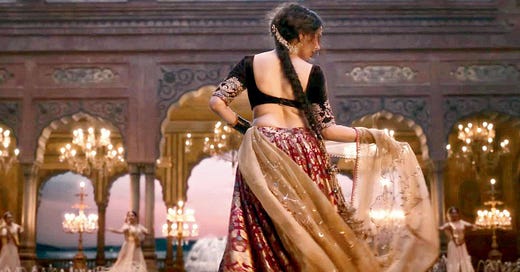The Gaja Gamini Walk: From Kama Sutra to its Current Revival in Heeramandi
Words by Divya Goyal
Welcome to the Brown History Newsletter. If you’re enjoying this labor of love, please do consider becoming a paid subscriber. Your contribution would help pay the writers and illustrators and support this weekly publication. If you like to submit a writing piece, please send me a pitch by email at brownhistory1947@gmail.com.
Don’t forget to check out our SHOP and our Podcast

Recommended Reads:
The Gaja Gamini Walk: From Kama Sutra to its Current Revival in Heeramandi
It’s just a walk… a slow, rhythmic seductive walk, which has enthralled the internet. Social media is flooded with glimpses of actress Aditi Rao Hydari, as courtesan Bibbojaan, performing “Saiyaan Hatto Jaao” with chutzpah in Indian filmmaker Sanjay Leela Bhansali’s latest cinematic spectacle “Heeramandi – The Diamond Bazaar.” Bibbojaan glides across the screen, her subtle expressions and slight sway in the steps mirroring the teachings of an Indian classical dance and that of an ancient Indian scripture – Vatsyayana’s Kama Sutra, a testament to the timeless elegance of eroticism.
As Aditi Rao Hydari walked into the hearts of many, the Internet dubbed the seductive walk as the Gaja Gamini walk – performed by a select few in Bollywood. Gaja Gamini, translating to "one who moves like an elephant" in Sanskrit, encapsulates a walk that mirrors the majestic and measured steps of an elephant. Speaking to the viralness of the scene, Aditi Rao Hydari tells the Hindustan Times, “Whatever I see on Instagram, reel upon reel, the whole viral nature of that tukda (piece) is so overwhelming. He (Sanjay Leela Bhansali) is very good at spotting magic on the spot and he created a lot of nuances in the process.” In another interview she added, “I really didn’t expect that (the song and move going viral) and Sanjay sir did say, ‘Ye chaal bahut important hai (This walk is very important)’.”
The Gaja Gamini walk blends sensuality and desire that transcends the boundaries of time and space. With each step, Bibbojaan embodies the essence of feminine allure and empowerment. And just like her Sahib, portrayed by Fardeen Khan, the audience also succumbs to her enchantment arriving in a world where desire is supreme.
The Four Types of Women Described in the Kama Sutra
To understand the allure of the Gaja Gamini walk, one has to trace its origin, which is deeply rooted in the guide of eroticism by Vatsyayana – the Kama Sutra. The author of this widely debated text, describes in detail four female archetypes—Padmini or the lotus-woman, Chitrini or the art-woman, Shankini or the conch-woman, and Hastini or the elephant-woman —each representing unique physical and emotional traits. In their own ways, these women are celebrated for their distinct characteristics and ties to specific aspects of beauty and elegance and among them, the Hastini stands out with her regal allure, likened to the majesty of a female elephant.







